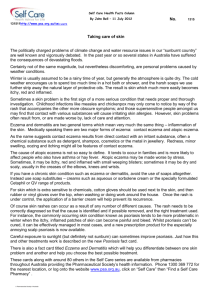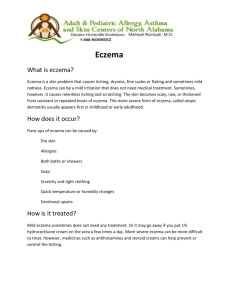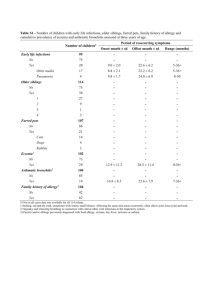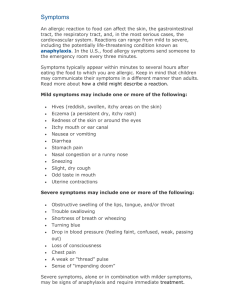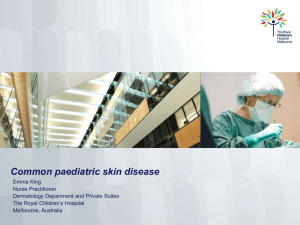Eczema (Atopic Dermatitis)
advertisement
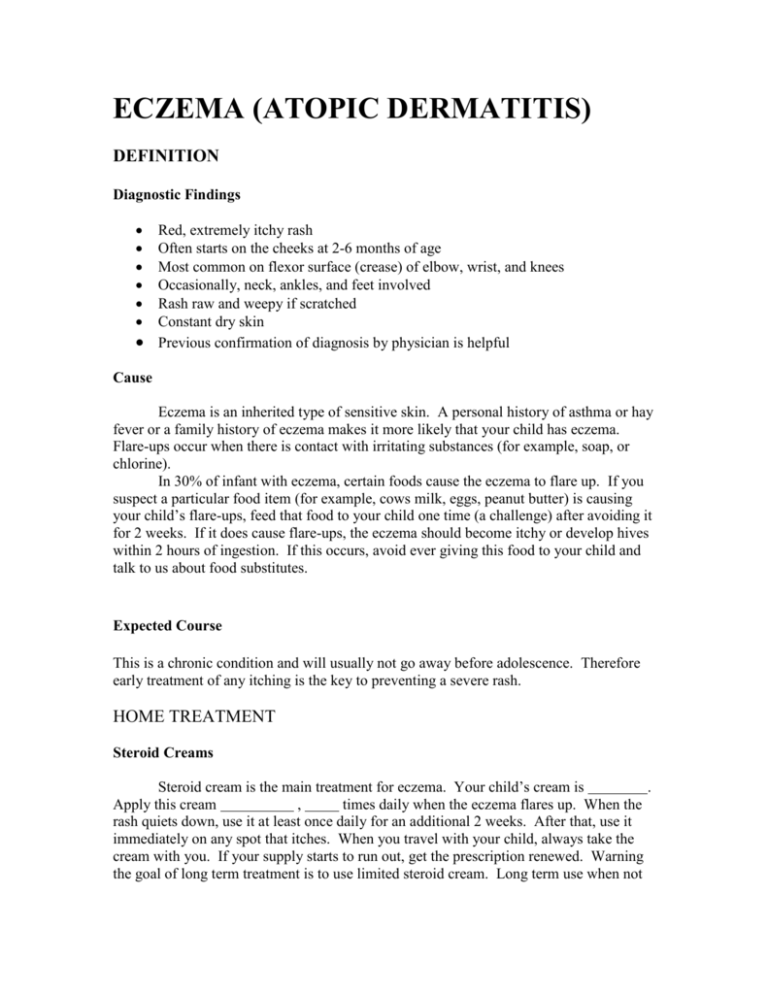
ECZEMA (ATOPIC DERMATITIS) DEFINITION Diagnostic Findings Red, extremely itchy rash Often starts on the cheeks at 2-6 months of age Most common on flexor surface (crease) of elbow, wrist, and knees Occasionally, neck, ankles, and feet involved Rash raw and weepy if scratched Constant dry skin Previous confirmation of diagnosis by physician is helpful Cause Eczema is an inherited type of sensitive skin. A personal history of asthma or hay fever or a family history of eczema makes it more likely that your child has eczema. Flare-ups occur when there is contact with irritating substances (for example, soap, or chlorine). In 30% of infant with eczema, certain foods cause the eczema to flare up. If you suspect a particular food item (for example, cows milk, eggs, peanut butter) is causing your child’s flare-ups, feed that food to your child one time (a challenge) after avoiding it for 2 weeks. If it does cause flare-ups, the eczema should become itchy or develop hives within 2 hours of ingestion. If this occurs, avoid ever giving this food to your child and talk to us about food substitutes. Expected Course This is a chronic condition and will usually not go away before adolescence. Therefore early treatment of any itching is the key to preventing a severe rash. HOME TREATMENT Steroid Creams Steroid cream is the main treatment for eczema. Your child’s cream is . Apply this cream , times daily when the eczema flares up. When the rash quiets down, use it at least once daily for an additional 2 weeks. After that, use it immediately on any spot that itches. When you travel with your child, always take the cream with you. If your supply starts to run out, get the prescription renewed. Warning the goal of long term treatment is to use limited steroid cream. Long term use when not absolutely necessary may cause damage to the skin. This usually doesn’t occur with short term (1-4 weeks) use. Bathing and Hydrating Skin Try to limit full baths 10-15 minutes 2-3 times a week. Water soaked skin is less itchy. Eczema is very sensitive to soaps. Young children can usually be cleaned without any soap. Teenagers need a soap to wash under the arms, the genitals area, and the feet. They can use a nondrying soap such as Dove for these areas. Keep shampoo off the eczema. You may use Cetaphil as a soap substitute. Lubricating Cream Children with eczema always have dry skin. After a 10 minutes bath, the skin is hydrated and feels good. Help trap the moisture in the skin by applying an outer layer of cream to the entire skin surface while it is damp. Apply it after steroid cream has been applied to any itchy areas. Apply the lubricating cream once daily (twice during the winter). Some lubricating creams are Keri, Lubriderm, Nivea, and Nutraderm. Avoid applying ointments, petroleum jelly, or vegetable shortening because they block the sweat glands, increasing itchy, and worsen the rash. Also, soap is needed to wash them off. For severe eczema, ointments may be needed temporarily to heal the skin. Itching At the first sign of any itching, apply the steroid cream to the area that itches. Keep your child’s fingernails cut short. Also, wash your child’s hands with water frequently to avoid infecting the eczema. Prevention Wool fibers and clothes made of other scratchy, rough materials make eczema worse. Cotton clothes should be worn as much as possible. Avoid triggers that cause eczema to flare up, such as excessive heat, sweating, excessive cold, dry air (use humidifier), chlorine, harsh chemicals, and soaps. Never use bubble bath. Also, keep your child off the grass during grass pollen season (May and June). Keep your child away from anyone with fever blisters since herpes virus can cause a serious skin infection in children with eczema. Try to breast-feed all high-risk infants. Also avoid cow’s milk products, soy, eggs, peanut butter, wheat, and fish during the first year of life. CALL OUR OFFICE Immediately if… The rash appears to be infected and your child has a fever. The rash flares up after contact with someone with fever blisters (herpes). Within 24 hours if… The rash becomes raw and bleeding in several places. The rash becomes infected, as evidenced by pus or soft yellow scabs. During regular hours if… The rash hasn’t greatly improved after 7 days of using this treatment. The itchy interferes with sleep. You have any questions or concerns.
